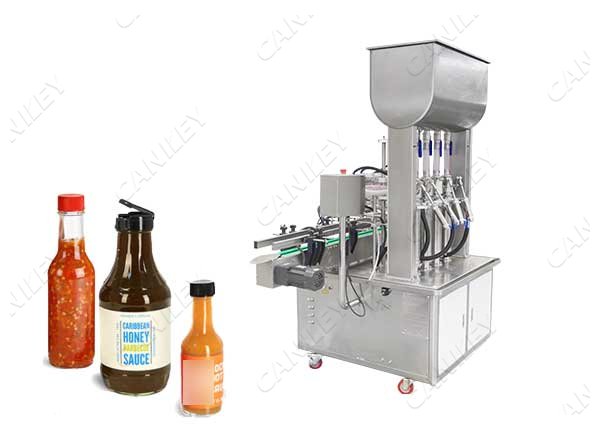Sauce Filling Machine Capacity
- Release Lime: May 10 2022
- Source: Sherry
The sauce filling machine capacity depends on the model of the machine. Different models of filling machines have different filling volumes and filling capacities. It is also related to the number of filling heads. Below we will explain from the degree of automation.

1. Semi automatic
This type of filling machine usually has 1-2 filling heads. Its filling capacity is less than 200 bottles/hour. It really depends on the speed of the worker.
# It belongs to the piston filling machine.
# Reasonable design, compact model, easy to operate.
# Material contact parts are made of 316L stainless steel, which meets GMP requirements.
# The filling volume and filling speed can be adjusted arbitrarily, and the filling precision is high.
2. Automatic
This type of filling equipment usually has 2-12 filling heads. Its filling capacity is 200-2000 bottles/hour. Only manual operation of the equipment is required.
# It is suitable for filling containers of different specifications, and the filling specifications can be switched within a few minutes.
# Short filling cycle and high production capacity.
# The replacement of filling specifications does not need to add equipment, just adjust the parameters to complete.
# Touch-operated color screen can display production status, operating procedures, filling methods, etc.
# Each filling head is equipped with a bottle cap device to ensure accurate injection alignment.
3. Full automatic
This type of filling machine usually has 18, 24, 36 filling heads. Its filling capacity is 2000-12000 bottles/hour. More automation.
# It integrates bottle washing, filling, capping, sleeve labeling and packaging. Using advanced atmospheric pressure filling principle, filling is fast, stable and accurate. Equipped with a complete material return system, it can also realize independent gas return during reflux without contact with materials, reducing secondary pollution and oxidation of materials.

1. Semi automatic
This type of filling machine usually has 1-2 filling heads. Its filling capacity is less than 200 bottles/hour. It really depends on the speed of the worker.
# It belongs to the piston filling machine.
# Reasonable design, compact model, easy to operate.
# Material contact parts are made of 316L stainless steel, which meets GMP requirements.
# The filling volume and filling speed can be adjusted arbitrarily, and the filling precision is high.
2. Automatic
This type of filling equipment usually has 2-12 filling heads. Its filling capacity is 200-2000 bottles/hour. Only manual operation of the equipment is required.
# It is suitable for filling containers of different specifications, and the filling specifications can be switched within a few minutes.
# Short filling cycle and high production capacity.
# The replacement of filling specifications does not need to add equipment, just adjust the parameters to complete.
# Touch-operated color screen can display production status, operating procedures, filling methods, etc.
# Each filling head is equipped with a bottle cap device to ensure accurate injection alignment.
3. Full automatic
This type of filling machine usually has 18, 24, 36 filling heads. Its filling capacity is 2000-12000 bottles/hour. More automation.
# It integrates bottle washing, filling, capping, sleeve labeling and packaging. Using advanced atmospheric pressure filling principle, filling is fast, stable and accurate. Equipped with a complete material return system, it can also realize independent gas return during reflux without contact with materials, reducing secondary pollution and oxidation of materials.

 0086-15515573212
0086-15515573212 info@cankeytech.com
info@cankeytech.com



 Your Location:
Your Location: